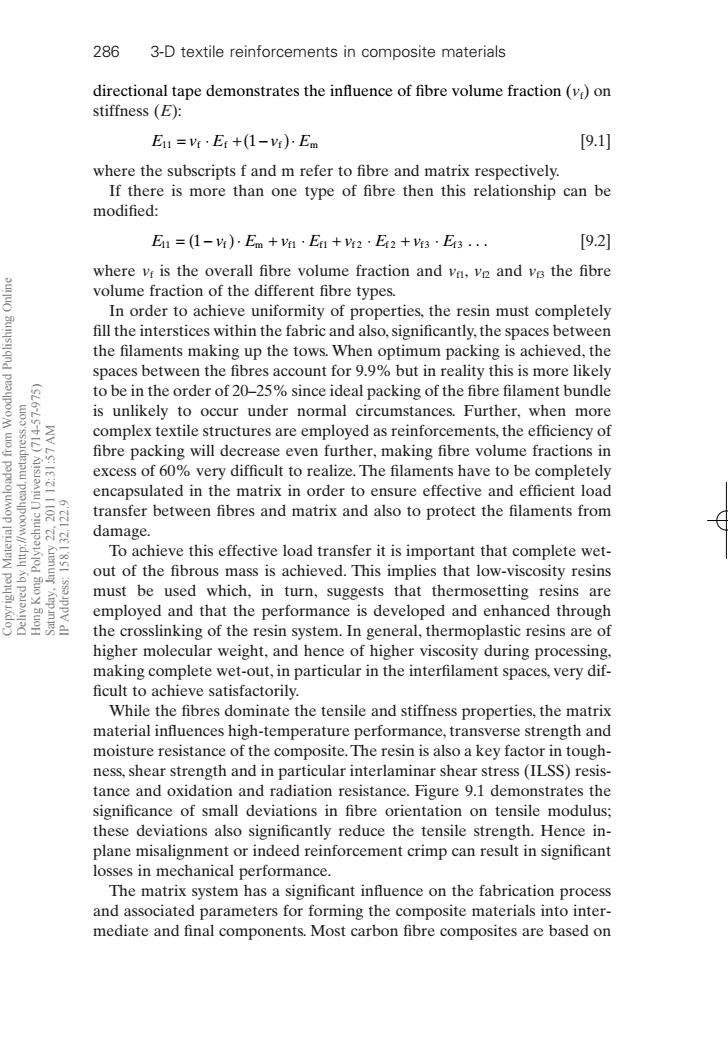正在加载图片...

286 3-D textile reinforcements in composite materials directional tape demonstrates the influence of fibre volume fraction (v)on stiffness (E): E11=v·Er+(1-v)Em [9.1] where the subscripts f and m refer to fibre and matrix respectively. If there is more than one type of fibre then this relationship can be modified: E1=(1-)Em+i·E1+2·E2+3·E3.. [9.2] where vr is the overall fibre volume fraction and va,vp and ve the fibre volume fraction of the different fibre types. In order to achieve uniformity of properties,the resin must completely fill the interstices within the fabric and also,significantly,the spaces between the filaments making up the tows.When optimum packing is achieved,the spaces between the fibres account for 9.9%but in reality this is more likely 9 to be in the order of 20-25%since ideal packing of the fibre filament bundle is unlikely to occur under normal circumstances.Further,when more complex textile structures are employed as reinforcements,the efficiency of fibre packing will decrease even further,making fibre volume fractions in 毒 2 excess of 60%very difficult to realize.The filaments have to be completely encapsulated in the matrix in order to ensure effective and efficient load transfer between fibres and matrix and also to protect the filaments from damage. To achieve this effective load transfer it is important that complete wet- out of the fibrous mass is achieved.This implies that low-viscosity resins must be used which,in turn,suggests that thermosetting resins are employed and that the performance is developed and enhanced through the crosslinking of the resin system.In general,thermoplastic resins are of higher molecular weight,and hence of higher viscosity during processing, making complete wet-out,in particular in the interfilament spaces,very dif- ficult to achieve satisfactorily. While the fibres dominate the tensile and stiffness properties,the matrix material influences high-temperature performance,transverse strength and moisture resistance of the composite.The resin is also a key factor in tough- ness,shear strength and in particular interlaminar shear stress(ILSS)resis- tance and oxidation and radiation resistance.Figure 9.1 demonstrates the significance of small deviations in fibre orientation on tensile modulus; these deviations also significantly reduce the tensile strength.Hence in- plane misalignment or indeed reinforcement crimp can result in significant losses in mechanical performance. The matrix system has a significant influence on the fabrication process and associated parameters for forming the composite materials into inter- mediate and final components.Most carbon fibre composites are based ondirectional tape demonstrates the influence of fibre volume fraction (vf) on stiffness (E): [9.1] where the subscripts f and m refer to fibre and matrix respectively. If there is more than one type of fibre then this relationship can be modified: [9.2] where vf is the overall fibre volume fraction and vf1, vf2 and vf3 the fibre volume fraction of the different fibre types. In order to achieve uniformity of properties, the resin must completely fill the interstices within the fabric and also, significantly, the spaces between the filaments making up the tows. When optimum packing is achieved, the spaces between the fibres account for 9.9% but in reality this is more likely to be in the order of 20–25% since ideal packing of the fibre filament bundle is unlikely to occur under normal circumstances. Further, when more complex textile structures are employed as reinforcements, the efficiency of fibre packing will decrease even further, making fibre volume fractions in excess of 60% very difficult to realize. The filaments have to be completely encapsulated in the matrix in order to ensure effective and efficient load transfer between fibres and matrix and also to protect the filaments from damage. To achieve this effective load transfer it is important that complete wetout of the fibrous mass is achieved. This implies that low-viscosity resins must be used which, in turn, suggests that thermosetting resins are employed and that the performance is developed and enhanced through the crosslinking of the resin system. In general, thermoplastic resins are of higher molecular weight, and hence of higher viscosity during processing, making complete wet-out, in particular in the interfilament spaces, very dif- ficult to achieve satisfactorily. While the fibres dominate the tensile and stiffness properties, the matrix material influences high-temperature performance, transverse strength and moisture resistance of the composite.The resin is also a key factor in toughness, shear strength and in particular interlaminar shear stress (ILSS) resistance and oxidation and radiation resistance. Figure 9.1 demonstrates the significance of small deviations in fibre orientation on tensile modulus; these deviations also significantly reduce the tensile strength. Hence inplane misalignment or indeed reinforcement crimp can result in significant losses in mechanical performance. The matrix system has a significant influence on the fabrication process and associated parameters for forming the composite materials into intermediate and final components. Most carbon fibre composites are based on E vE vE v E vE 11 1 1 2 2 3 3 = - ( ) 1 ◊ +◊ + ◊ +◊ f mf f f f f f . . . E vE v E 11 =◊ +- ( ) 1 ◊ ff f m 286 3-D textile reinforcements in composite materials RIC9 7/10/99 8:32 PM Page 286 Copyrighted Material downloaded from Woodhead Publishing Online Delivered by http://woodhead.metapress.com Hong Kong Polytechnic University (714-57-975) Saturday, January 22, 2011 12:31:57 AM IP Address: 158.132.122.9